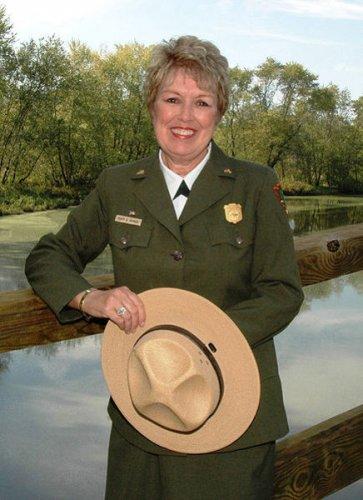Although it may seem to be just for show, that distinctive pinch in the crown of the national park ranger's iconic hat actually originated as a practical solution to a significant problem.
The broad-brimmed, high-crowned hat that national park rangers wear with their class A uniform was first specified as National Park Service apparel in the agency's 1920 uniform regulations. Since this was only four years after Congress created the National Park Service, the hat that rangers call the "flat hat" is one of the agency's longest-standing traditions. It is instantly recognized, though many people will tell you that it's a "Smokey Bear hat" and some will say it's a Stetson.
The Montana Peak
The crown of the ranger hat is not just high, it is also pinched into symmetrical quadrants. The pinch, which is formally known as a Montana Peak (aka Montana Crease), has a shape that prompts some people to call the hat a "lemon squeezer."
Whatever you may call it, the distinctive pinch in the ranger hat's crown was not a National Park Service innovation. This design characteristic actually came into use over a century ago after U.S. Army troopers learned that adding a symmetrical quadrant pinch to the crown of a standard issue campaign hat rendered it more useful.
In 1898, American cavalrymen sent to fight in Cuba and the Philippines during the Spanish American War wore campaign hats very similar to modern ranger hats. These soldiers had to cope with torrential tropical rains, and they found that their hats would shed rain better if the crowns were pinched into symmetrical quadrants -- a Montana Peak -- instead of the fore-and-aft crease of the regulation M1883 or M1903 campaign hat.
Whether this trick might have originated elsewhere, and sooner, is still debated. In any event, photographs and anecdotal evidence confirm that many Spanish American War veterans had this non-regulation "lemon squeezer" pinch in their campaign hats after the war ended and they were reassigned to stateside duty.
The Cavalry Patrol Era in the Parks
How this design feature came to be adopted by the National Park Service is well documented as a case of military influence. The first national parks were established in the 1870s, long before there was a National Park Service. In the early years (beginning in 1886), the U.S. Army patrolled the parks and enforced the law. Mounted troopers were trained and equipped to operate in rugged, remote areas, so this job went to the cavalry. Civilian park rangers did not officially replace troopers in the parks until 1914.
The Buffalo Soldiers Legacy
Buffalo Soldiers are credited with introducing the Montana Peak campaign hat to the national parks. Many of the black troopers assigned to patrol Yosemite National Park and several other California national parks during 1890-1905 were Spanish American War veterans who maintained the symmetrical quadrant pinch in the crown of their campaign hats when they returned from the war. Other troopers began using the pinch too, even though the Army's uniform regulations did not add the Montana Peak to the trooper's regulation campaign hat until September 1911.
The First Official Park Uniform Had a Military Look
In that same year of 1911, a time when troopers were still patrolling some national parks, the Department of the Interior approved the first official uniform for civilian park rangers. Not surprisingly, this uniform, which was meant to clearly identify its wearer as a park employee, had a very military look to it. In fact, if you ignored the ranger tunic, a quick glance at the breeches, puttees, and campaign hat might have led you to believe you were looking at a cavalry officer.
The Lemon Squeezer is a True Classic
In the ensuing decades, the park ranger's class A uniform evolved away from its copycat military origins. A few things have stayed pretty much the same though, and one of them is that flat hat with its distinctive Montana Peak.




Comments
That was absolutely fascinating!
Thank you, Bob. Just one more reason why NPT is a terrific website.
I have always wondered about that...thanks for answering!
When I was a seasonal ranger, one day a visitor asked me whether working in the Park Service was like being in the military. I replied that no, while the army had originally run the parks, it wasn't like that now. "Have any rules for that uniform?" he asked. "Well, yes. If you're inside a building, you take off your hat. But if you're just passing through a building, you leave it on." "See?" he replied. "It's just like the army."
Anyone interested in the history of the NPS uniform should read works by Bryce Workman, who is retired from the NPS Harpers Ferry Center in Harpers Ferry, WV. There are great pictures in the books, including white "go-go" boots and the minidress to go with them.
Thanks, Judy. Traveler readers might want to have a look at this uniform at this site. We'd be interested to know what you think of it.
BTW, we cordially invite you to stay tuned. If we can ever get out from under our backlog, we'll launch a series of articles on NPS uniform history.
Too bad the hats aren't waterproof.
Great info... many park guests ask about the reason for the "flat hat"... unfortunately when the wind blows, you are lifted off the ground!! :)
---The Night Ranger, Badlands NP
Thanks for the information about the hat! I was asked about the "Smokey the Bear" hat when I worked as a seasonal ranger, as well as about the military-style uniform worn by rangers (which was quite different from--and less comfortable than--the costumes I wore as a seasonal costumed interpreter).